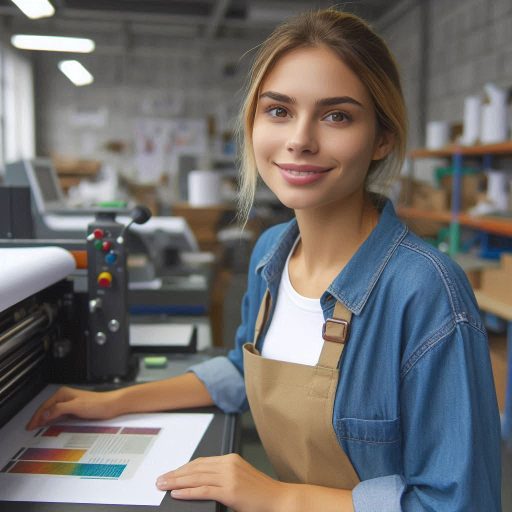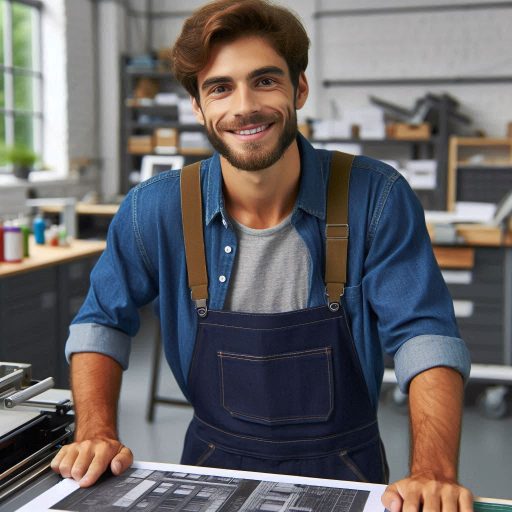Introduction
Printmaking is a diverse and captivating art form.
It involves creating images by transferring ink from a matrix to a surface.
This matrix can be wood, metal, or stone.
Printmaking techniques include etching, lithography, and screen printing.
Each method offers unique textures and effects, allowing artists to explore creativity in various ways.
Printmaking exhibitions and events play a crucial role in the art world.
They provide a platform for artists to showcase their work to a wider audience.
These events foster connections between artists, collectors, and art enthusiasts.
They also offer a space for dialogue about artistic techniques and trends.
By highlighting different styles and approaches, exhibitions contribute to the appreciation of printmaking as a significant art form.
The popularity of printmaking exhibitions has surged in recent years.
They attract large crowds, from dedicated art lovers to casual viewers.
Major galleries and museums worldwide host these events, drawing attention to the versatility of printmaking.
Each exhibition brings together a range of artists, presenting their work in innovative and engaging ways.
This growing interest underscores the importance of printmaking in contemporary art and culture.
History of Famous Printmaking Exhibitions and Events
Printmaking has a long and rich history, dating back to the ancient civilizations of Mesopotamia and China.
The invention of the printing press by Johannes Gutenberg in the 15th century revolutionized the way information and art were disseminated.
Key Events in Printmaking Industry
- The development of techniques such as woodcut, engraving, etching, and lithography expanded the possibilities of printmaking.
- The establishment of printmaking guilds in Europe during the Renaissance period helped in the standardization and promotion of the art form.
- The Arts and Crafts movement of the late 19th century emphasized the importance of handcraftsmanship in printmaking.
Impact of Events on the Art World
The democratization of art through printmaking allowed for wider accessibility and affordability, leading to a greater appreciation for graphic arts.
Renowned Printmaking Exhibitions
- The International Print Biennale in Newcastle, UK, is a prestigious event that showcases contemporary printmaking from around the world.
- The Print Fair at the Royal Academy of Arts in London features a wide range of printmaking techniques and attracts art enthusiasts and collectors.
- The Southern Graphics Council International Conference is an annual gathering of printmakers, educators, and students that includes exhibitions, demonstrations, and workshops.
Famous printmaking exhibitions and events have played a significant role in shaping the art world and promoting the diverse and intricate craft of printmaking.
These events continue to inspire and showcase the creativity and innovation of printmakers globally.
Transform Your Career Today
Unlock a personalized career strategy that drives real results. Get tailored advice and a roadmap designed just for you.
Start NowRead: The Role of Printmaking in Contemporary Art
Notable Printmakers in Famous Printmaking Exhibitions
Some of the most renowned printmakers have participated in these prestigious exhibitions, showcasing their talent and creativity.
- Pablo Picasso
- Rembrandt van Rijn
- Albrecht D‘rer
- Katsushika Hokusai
- Andy Warhol
Influence of these Artists on the Printmaking Community
Their unique styles and techniques have greatly influenced the printmaking community, setting new standards and pushing boundaries.
- Pablo Picasso: Picasso’s innovative approach to printmaking, such as his use of multiple plates and colors, has inspired countless artists.
- Rembrandt van Rijn: Rembrandt’s mastery of light and shadow, as seen in his etchings, has become a cornerstone of printmaking technique.
- Albrecht D‘rer: D‘rer’s meticulous attention to detail and precision in his engravings have set a benchmark for printmakers worldwide.
- Katsushika Hokusai: Hokusai’s iconic woodblock prints, especially his “Great Wave,” have left a lasting impact on printmaking aesthetics.
- Andy Warhol: Warhol’s pop art prints and use of mass production techniques have revolutionized the way we view printmaking as an art form.
Their Unique Styles and Techniques
Each of these artists brought something distinct to the table, whether it was their use of color, texture, or subject matter.
- Picasso’s bold colors and abstract forms
- Rembrandt’s dramatic use of light and shadow
- D‘rer’s intricate details and precision
- Hokusai’s dynamic compositions and nature themes
- Warhol’s vibrant colors and commercial imagery
Inspiring the Next Generation of Printmakers
These artists have paved the way for future generations, showing them the endless possibilities that printmaking offers.
- Continuing Legacy: Many contemporary printmakers draw inspiration from these masters, incorporating their techniques into modern practices.
- Educational Impact: Art schools and institutions often use the works of these printmakers as teaching tools, showcasing their innovation and creativity.
- Cultural Influence: Through their prints, these artists have captured the essence of their time, making their work timeless and relevant to new audiences.
- Encouraging Experimentation: By pushing the boundaries of traditional printmaking, these artists have encouraged others to experiment with new techniques and approaches.
Overall, the contributions of these famous printmakers have not only shaped the past but continue to inspire and influence the future of printmaking.
Read: The Role of Technology in Modern Printmaking
Significance of Printmaking Exhibitions in Promoting Diversity
Printmaking exhibitions play a crucial role in promoting diversity within the art world.
These events provide a platform for artists from various backgrounds to showcase their work and tell their unique stories through printmaking techniques.
By highlighting a range of artistic voices, printmaking exhibitions help to break down barriers and foster inclusivity within the art community.
Exploration of Artistic Voices in Printmaking Events
Printmaking exhibitions showcase a diverse array of artistic voices, each with its own perspective and style.
This diversity enriches the art world by introducing new ideas, aesthetics, and cultural influences.
Through these events, viewers can experience a wide range of artistic expressions that challenge and inspire.
Representation of Cultures and Perspectives Through Printmaking
One of the key benefits of printmaking exhibitions is the representation of different cultures and perspectives.
Artists from around the world use printmaking techniques to explore their heritage, beliefs, and experiences.
This representation helps to create a more inclusive and globally-minded art community.
Examples of Printmaking Exhibitions Highlighting Diversity
Several printmaking exhibitions have successfully highlighted diversity in the art world.
“Global Impressions” at the International Print Center New York featured prints from artists across continents, showcasing a rich tapestry of cultural influences.
The exhibition emphasized the importance of cross-cultural dialogue and understanding through art.
Showcase Your Business Today
Reach thousands of readers actively exploring professional services. Publish your business profile and grow your audience now.
Publish NowIn another example, the “Diverse Voices in Print” exhibition at the British Museum celebrated the work of printmakers from diverse backgrounds.
The exhibition featured prints that addressed themes of identity, migration, and social justice, offering viewers a thought-provoking exploration of contemporary issues through the lens of printmaking.
Overall, printmaking exhibitions are essential for promoting diversity and inclusivity in the art world.
These events provide a platform for artists to share their unique perspectives and for viewers to engage with a wide range of artistic voices.
Through printmaking, different cultures and perspectives can be represented, fostering a more interconnected and understanding global art community.
Read: Marketing Strategies for Printmakers

Examination of the role of technology in modern printmaking exhibitions
Technology plays a crucial role in modern printmaking exhibitions by enabling artists to explore new techniques and push the boundaries of traditional printmaking.
With advancements in digital technology, artists now have access to a wide range of tools and software that allow them to create intricate and complex prints that were previously impossible.
One of the key ways technology has revolutionized printmaking exhibitions is through the use of digital printing.
Digital printing has significantly streamlined the printing process, making it faster and more efficient than traditional methods.
Artists can now easily transfer their designs onto various surfaces with precision and detail, opening up new possibilities for creative expression.
Furthermore, the integration of traditional and digital techniques in printmaking exhibitions has led to innovative and experimental artworks.
Artists are now combining traditional printmaking methods such as etching and screenprinting with digital tools like Photoshop and Illustrator to create unique and visually striking prints that push the boundaries of the medium.
How digital printing has revolutionized the industry
Digital printing has revolutionized the printmaking industry by making the process more accessible, affordable, and environmentally friendly.
Artists no longer have to rely on costly and time-consuming traditional printing methods; instead, they can create high-quality prints quickly and efficiently using digital technology.
Additionally, digital printing has opened up new possibilities for printmakers to experiment with different materials and substrates.
Artists can now print on a wide variety of surfaces, from paper and canvas to metal and wood, giving them the freedom to explore new textures and effects in their work.
Moreover, digital printing allows artists to reproduce their prints in large quantities without compromising on quality.
This has made it easier for artists to sell their work to a broader audience, further expanding the reach and impact of printmaking exhibitions.
Integration of traditional and digital techniques in printmaking exhibitions
The integration of traditional and digital techniques in printmaking exhibitions has created a dynamic and diverse landscape in the art world.
Artists are now blending centuries-old printmaking methods with cutting-edge digital tools to create innovative and contemporary artworks that resonate with audiences.
By combining traditional techniques such as woodcutting and lithography with digital design software, artists can achieve a level of intricacy and detail that was previously unattainable.
This fusion of old and new allows artists to express their creative vision in ways that were never before possible, leading to a renaissance in printmaking exhibitions.
Furthermore, the integration of traditional and digital techniques has democratized the art world by making printmaking more accessible to a wider range of artists.
Emerging artists can now experiment with digital tools and techniques to create prints that rival those of established artists, leveling the playing field and fostering a more inclusive and diverse artistic community.
Discussion on the future of printmaking events in the digital age
The future of printmaking events in the digital age is filled with exciting possibilities and opportunities for innovation.
As technology continues to advance, we can expect to see even more groundbreaking collaborations between traditional and digital artists, leading to a new era of experimental and boundary-pushing printmaking exhibitions.
Digital technology will play an increasingly central role in the creation and presentation of prints, allowing artists to explore new techniques and styles that were previously unimaginable.
Virtual reality and augmented reality are also likely to become integral components of printmaking events, providing audiences with immersive and interactive experiences that blur the lines between the physical and digital worlds.
Moreover, the democratization of printmaking through digital tools and platforms will continue to expand, giving artists from diverse backgrounds and disciplines the opportunity to showcase their work to a global audience.
Printmaking events in the digital age will not only celebrate the rich history and tradition of the medium but also pave the way for a future of innovation, collaboration, and creative expression.
Read: Printmaking for Children‘s Art Education
Impact of printmaking exhibitions on the art market
Printmaking exhibitions have a significant impact on the art market.
These events showcase the talent and creativity of printmakers from around the world, attracting art enthusiasts and collectors alike.
Contribution to the Value of Printmaking
Printmaking exhibitions play a crucial role in increasing the value of prints.
When artists participate in these events, their work gains exposure and recognition, leading to a surge in demand for their prints.
Increase in Demand for Prints
Art collectors often seek out prints from artists who have been featured in prestigious printmaking exhibitions.
This heightened demand results in an increase in the value of these prints, making them more attractive to collectors.
Economic Effects of Hosting Printmaking Exhibitions
Hosting printmaking exhibitions can have positive economic effects on the local community.
These events attract visitors, including art enthusiasts and tourists, who contribute to the local economy by patronizing restaurants, hotels, and other businesses.
Showcase Your Business Today
Reach thousands of readers actively exploring professional services. Publish your business profile and grow your audience now.
Publish NowMoreover, the sale of prints during these exhibitions generates revenue for both the artists and the organizers.
This infusion of capital helps support the arts and cultural sector, further contributing to the economic growth of the community.
In review, printmaking exhibitions are not only significant in promoting the art form but also in boosting the art market.
The exposure and recognition gained by artists, the increase in the value of prints, and the economic impact on the host community all make these events invaluable in the world of art.
Uncover the Details: Impact of Lighting Design on Interior Spaces
Challenges faced by printmaking exhibitions and events
Lack of funding and support for printmaking initiatives
Printmaking exhibitions often struggle with limited funding.
Many printmaking initiatives rely on grants and sponsorships that are hard to secure.
This financial strain impacts the quality and scale of exhibitions.
Without sufficient funds, organizers may face difficulties in promoting and hosting successful events.
Securing adequate resources for materials, space, and publicity becomes a significant challenge.
Limited financial backing can also affect the ability to attract high-profile artists and sponsors.
Competition from other art forms and exhibitions
Printmaking exhibitions face fierce competition from other art forms and exhibitions.
Visual arts, including painting and sculpture, often draw larger audiences and more attention.
Other forms of art might receive more media coverage and public interest.
This competition can overshadow printmaking events, making it harder for them to gain recognition.
The diverse interests of art-goers also mean that printmaking must vie for attention in a crowded field.
Strategies for overcoming these challenges and ensuring the success of printmaking events
To overcome funding challenges, printmaking exhibitions should diversify their revenue streams.
They can seek sponsorships from businesses and apply for multiple grants.
Crowdfunding platforms also offer a way to engage with supporters directly.
To combat competition, printmaking events can focus on unique themes or innovative formats.
Collaborations with other art forms and cross-disciplinary exhibitions can attract a broader audience.
Effective marketing and outreach are essential for building awareness and generating interest.
Engaging with local communities and educational institutions can further enhance visibility and support.
By addressing these challenges strategically, printmaking exhibitions can achieve greater success and prominence in the art world.
Conclusion
Printmaking exhibitions and events have played a crucial role in showcasing the beauty and diversity of this artistic medium.
These events have provided a platform for artists to share their work with a wider audience, fostering creativity and innovation.
As art enthusiasts, it is essential for us to support these exhibitions to ensure the continued growth and appreciation of printmaking.
Printmaking exhibitions leave a lasting impact on the art world, inspiring future generations of artists and art enthusiasts to explore this unique medium.
Let’s continue to celebrate and attend these events to keep the legacy alive.
[E-Books for Sale]
The Big Book of 500 High-Paying Jobs in America: Unlock Your Earning Potential
$19.99 • 500 High-Paying Jobs • 330 pages
Explore 500 high-paying jobs in America and learn how to boost your career, earn more, and achieve success!
See All 500 High-Paying Jobs of this E-Book
1001 Professions Without a Degree: High-Paying American Jobs You Can Start Now
$19.99 • 1001 Professions Without a Degree • 174 pages
Discover 1001 high-paying jobs without a degree! Unlock career tips, skills, and success strategies for just $19.99!




